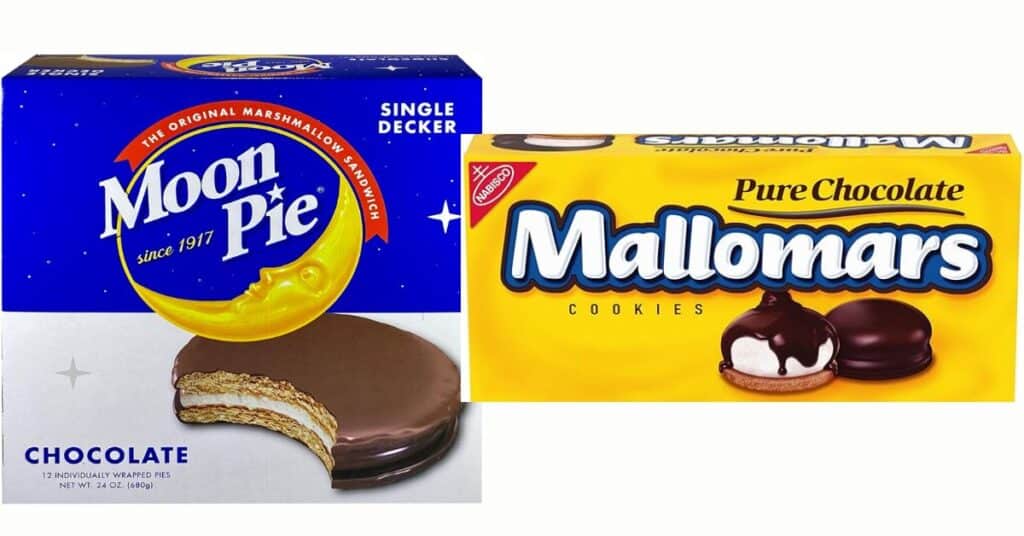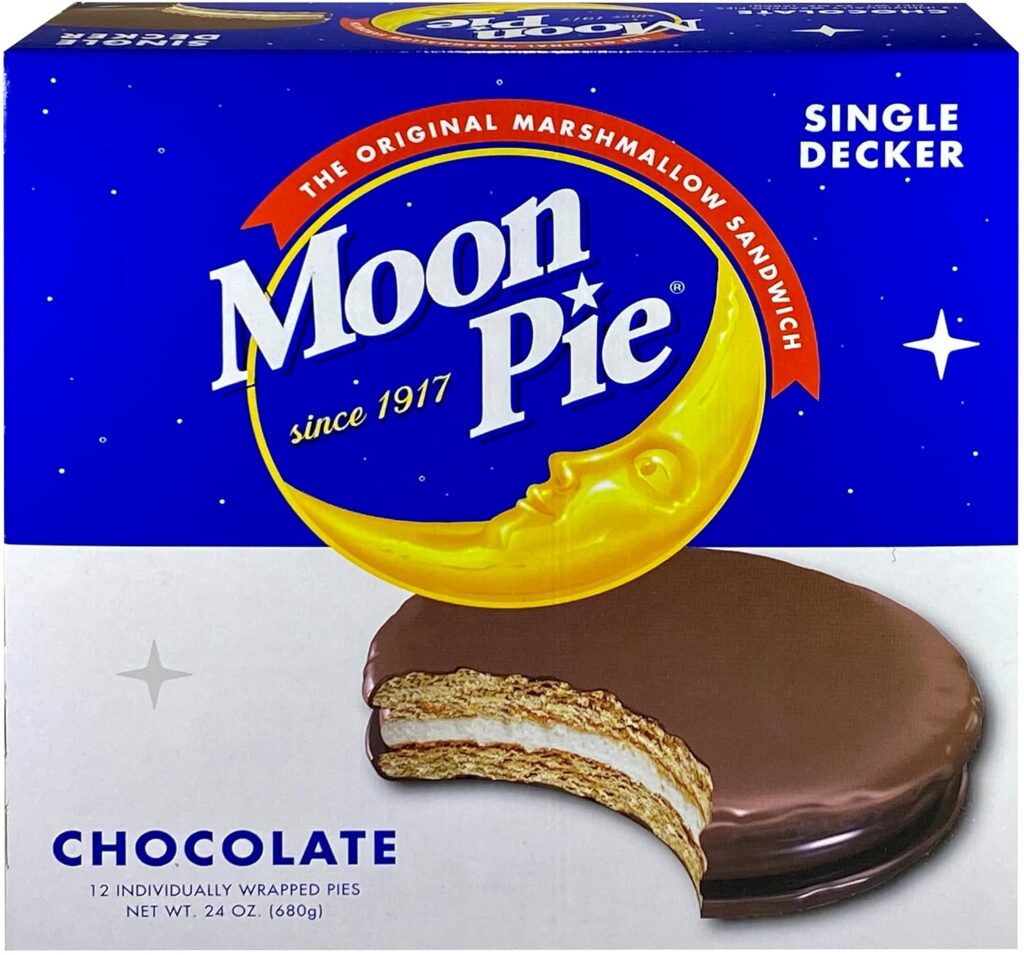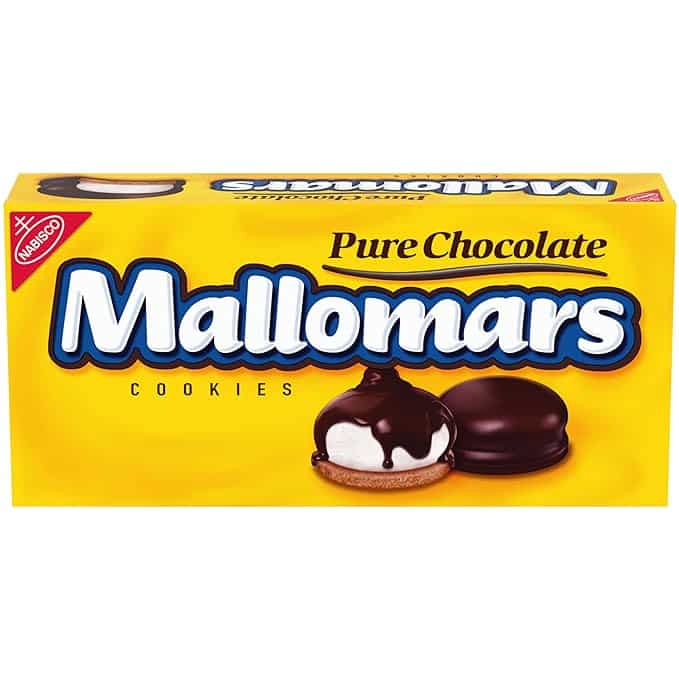When you think of a snack that combines the richness of chocolate with the softness of marshmallow, two classic treats probably come to mind: Moon Pies and Mallomars. Both of these desserts have been satisfying sweet tooths for generations, each with its unique charm. Moon Pies, originating from the Southern United States, present a tantalizing combination of marshmallow sandwiched between two graham cracker cookies, coated in a luscious layer of chocolate.

On the other hand, Mallomars capture the essence of a campfire s’more in a single bite. A marshmallow is perched atop a graham cracker base and then enrobed in dark chocolate, creating a delightful treat with a more refined flavor profile. Each has its own dedicated fan base and classic recipe that has stood the test of time, making the debate over which one reigns supreme a common discussion among dessert enthusiasts.
You might have your personal preference between these two iconic snacks, but the delightful experience of biting into either a Moon Pie or a Mallomar is where the joy truly lies. Both treats share the heartwarming combination of marshmallow and chocolate, yet their textures and taste nuances can be quite distinct, inviting you to explore your palate preferences. Whether you’re a long-time fan or a curious newcomer to these indulgences, unpacking the qualities of each can be as enjoyable as the treats themselves.
History and Origin
While both Moon Pie and Mallomar have secured their places in American snack history, their origins reflect distinct cultural roots—Moon Pie in the South and Mallomar in the Northeast.
Moon Pie’s Southern Roots
The Moon Pie originated in 1917 at the Chattanooga Bakery in Tennessee. Origin stories suggest a kentucky coal miner requested a snack “as big as the moon,” which led to the creation of this iconic treat. Earl Mitchell, a salesman, reportedly took the idea back to the bakery, where they concocted a marshmallow sandwich of graham crackers dipped in chocolate. It paired perfectly with RC Cola, especially popular in the South, becoming a working-class lunch staple during World War II.
Mallomars: A Northeastern Delicacy
In contrast, Mallomars were introduced by Nabisco in 1913 in West Hoboken, NJ (now Union City). A true northeastern delicacy, these cookies are composed of a marshmallow on top of a graham cracker base, coated in dark chocolate. Hailed as a seasonal treat due to its delicate chocolate shell, Mallomars are traditionally sold from September to March, avoiding the warm months where they might melt before reaching your mouth.
Cultural Significance
These treats go beyond mere indulgence; they’re a slice of Americana. Moon Pie, akin to the Southern whoopie pie, has become symbolic in Mobile, Alabama, where a giant electronic Moon Pie is dropped in celebration of New Year’s Eve. The snack is even dubbed the “kitchen sink” pie, inclusive of everything but that. The Presbyterian minister’s pie—Mallomar—has likewise captured hearts, garnering a devoted fan base that eagerly awaits its seasonal return. Each, in its own way, tells a story of regional pride and the inventive spirit that characterizes American confectionery traditions.
Composition and Ingredients
In this section, you’ll discover what Moon Pies and Mallomars are made of, from the crunchy base to the sweet coating. Let’s examine the ingredients that give these treats their distinctive flavors.
Analyzing the Graham Cracker Foundation
Moon Pies and Mallomars both start with a graham cracker base. These crackers typically consist of graham flour (coarse-ground wheat flour mixed with bran), sugar, and butter, creating a sturdy and flavorful foundation. A Moon Pie’s graham cracker may have honey or brown sugar to enhance its sweetness, while Mallomars often utilize wheat flour and may include more subtle flavorings like vanilla.
Marshmallow Filling: A Sweet Comparison
The marshmallow filling in both treats is a fluffy layer made from sugar, corn syrup, gelatin, and egg whites. The marshmallows in a Moon Pie are often a bit firmer, sometimes containing a touch of vanilla for flavor. In contrast, Mallomars might have a lighter, airier marshmallow, which is whipped with egg whites and gelatin to achieve its soft texture.
Chocolate Coating: Taste and Texture
Finally, the chocolate coating is a defining feature. Moon Pies are enrobed in a thin layer of chocolate-flavored coating made from cocoa, sugar, and oils, which gives it a distinctively sweet taste and a smooth texture that can withstand varied temperatures. Mallomars, on the other hand, boast a dark chocolate coating that contributes to a richer flavor and a more luxurious mouthfeel that can melt more easily, requiring cooler storage conditions.
Variants and Flavors
When you think of Moon Pies and Mallomars, you might envision the classic versions of these beloved treats. Yet, they offer a tantalizing array of flavors and seasonal varieties that might just exceed your expectations.
Exploring Flavor Innovations

Moon Pies have come a long way from their original marshmallow, graham, and chocolate combination. You can indulge in different flavors that include:
- Banana: A sweet twist with real banana flavor.
- Strawberry: Perfect for those who love a fruitier note in their snack.
- Salted Caramel: A balance of sweet and savory for a mature palette.
- Vanilla extract: A subtle, rich flavor that transforms the traditional treat.
For dipping enthusiasts, a flavored coating might just elevate your snacking experience. Imagine dipping your Moon Pie in dark chocolate for an extra decadent treat or enjoying a s’mores version that brings the campfire to your tastebuds.

Mallomars, while often sticking to their iconic chocolate and marshmallow pairing, have been known to experiment with taste too. They might not have as many flavor variants as Moon Pies, but they’ve been known to include:
- Dark Chocolate: A richer, more intense chocolate experience.
- Vanilla: A light and creamy alternative.
Dietary and Seasonal Varieties
The joy of Moon Pies and Mallomars is that they consider your dietary preferences and festive spirits. You can find options like:
- Coconut Oil: Used as a substitute for other oils to cater to specific dietary needs.
- Seasonal Varieties: Limited-time offerings that embody the spirit of holidays, like Christmas or Halloween.
During certain times of the year, keep an eye out for seasonal flavors that can range from pumpkin spice to mint, creating a perfect companion for your seasonal festivities. Whether you’re seeking a comforting winter snack or a summer fair novelty, the companies behind these treats make sure you have something special to mark the season.
Remember, alternative names for these sweets might pop up depending on where you are or the time of the year, so stay curious and explore the aisles for new and exciting flavors that might just make your day a little sweeter.
Cultural and Social Impact
Moon Pies and Mallomars have both had unique impacts on culture and society, becoming more than just treats to enjoy. They’ve infiltrated traditions, holidays, and media, each earning a special place in American hearts.
Moon Pie in Traditions and Festivities
Your enjoyment of Moon Pies might extend beyond their marshmallow and graham cookie goodness. In Kentucky, these treats are a staple, especially during the holiday season where homemade versions often make an appearance. The iconic Krewe of Mona Lisa and Moonpie parades in Louisiana showcase the cultural significance of the Moon Pie, turning it into a symbol of revelry during Mardi Gras festivities. It’s common to see these treats thrown from floats, much like beads, with parade-goers eagerly catching them.
Aside from holidays, Moon Pies have also partnered with another southern classic, RC Cola, to become a significant part of the working-class lunch tradition, particularly among military veterans. This combination is a nostalgic nod to simpler times and a quick, satisfying snack.
Mallomars in Pop Culture and Media
Mallomars capture the essence of seasonal joy as they are traditionally sold from September to March, giving you a reason to celebrate their return each fall. The rarity outside these months lends Mallomars a sense of exclusivity.
This seasonal treat has found its way into the limelight through mentions in books and television, notably recognized in works by Christopher Priest, where their distinct marshmallow and graham cookie composition get a nod. Additionally, the Mallomar’s influence can be seen in the broader world of candy with its fancied comparison to Whoopie Pies, adding to its pop culture footprint.
Frequently Asked Questions

In this section, you’ll find answers to some of the most common questions about Moon Pies and Mallomars, from their distinct characteristics to their origins and variety of flavors.
What are the differences between Moon Pies and Mallomars?
Moon Pies consist of two graham cookies with a marshmallow filling in the center, coated in chocolate. Mallomars share the marshmallow and chocolate coating but differ with a single graham cracker base and a dome-like shape.
Who is responsible for the creation of Moon Pies?
The Chattanooga Bakery in Tennessee is credited with the creation of Moon Pies in 1917 when a coal miner asked for a snack “as big as the moon.”
Can you list the available flavors of Moon Pies and how they are ranked?
Moon Pies come in various flavors such as chocolate, vanilla, banana, and salted caramel. Chocolate is often the most popular and traditional choice, followed closely by banana.
What are the common nicknames for Moon Pies, and how did they come about?
Moon Pies are affectionately called “moon pucks,” “marshmallow sandwiches,” or “graham pies.” These nicknames arose from their shape and ingredients reflecting the pie-like aspect of the treat.
Are there any recipes for making homemade Moon Pies?
Yes, numerous recipes exist for making your own Moon Pies, typically involving graham cracker dough, homemade marshmallow filling, and a chocolate dip.
What is the historical background of Moon Pies?
Moon Pies became a Southern staple during the Great Depression because of their size and affordability. Their popularity soared when paired with RC Cola, becoming the working man’s lunch.
